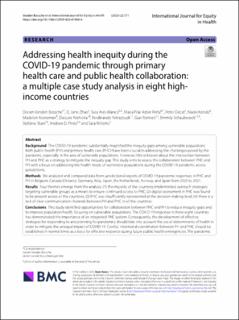| dc.contributor.author | Vanden Bossche, Dorien | |
| dc.contributor.author | Zhao, Q. Jane | |
| dc.contributor.author | Ares-Blanco, Sara | |
| dc.contributor.author | Peña, Maria Pilar Astier | |
| dc.contributor.author | Decat, Peter | |
| dc.contributor.author | Kondo, Naoki | |
| dc.contributor.author | Kroneman, Madelon | |
| dc.contributor.author | Nishioka, Daisuke | |
| dc.contributor.author | Petrazzuoli, Ferdinando | |
| dc.contributor.author | Rørtveit, Guri | |
| dc.contributor.author | Schaubroeck, Emmily | |
| dc.contributor.author | Stark, Stefanie | |
| dc.contributor.author | Pinto, Andrew D. | |
| dc.contributor.author | Willems, Sara | |
| dc.date.accessioned | 2024-03-19T12:37:32Z | |
| dc.date.available | 2024-03-19T12:37:32Z | |
| dc.date.created | 2023-10-13T13:09:17Z | |
| dc.date.issued | 2023 | |
| dc.identifier.issn | 1475-9276 | |
| dc.identifier.uri | https://hdl.handle.net/11250/3123127 | |
| dc.description.abstract | Background
The COVID-19 pandemic substantially magnified the inequity gaps among vulnerable populations. Both public health (PH) and primary health care (PHC) have been crucial in addressing the challenges posed by the pandemic, especially in the area of vulnerable populations. However, little is known about the intersection between PH and PHC as a strategy to mitigate the inequity gap. This study aims to assess the collaboration between PHC and PH with a focus on addressing the health needs of vulnerable populations during the COVID-19 pandemic across jurisdictions.
Methods
We analyzed and compared data from jurisdictional reports of COVID-19 pandemic responses in PHC and PH in Belgium, Canada (Ontario), Germany, Italy, Japan, the Netherlands, Norway, and Spain from 2020 to 2021.
Results
Four themes emerge from the analysis: (1) the majority of the countries implemented outreach strategies targeting vulnerable groups as a means to ensure continued access to PHC; (2) digital assessment in PHC was found to be present across all the countries; (3) PHC was insufficiently represented at the decision-making level; (4) there is a lack of clear communication channels between PH and PHC in all the countries.
Conclusions
This study identified opportunities for collaboration between PHC and PH to reduce inequity gaps and to improve population health, focusing on vulnerable populations. The COVID-19 response in these eight countries has demonstrated the importance of an integrated PHC system. Consequently, the development of effective strategies for responding to and planning for pandemics should take into account the social determinants of health in order to mitigate the unequal impact of COVID-19. Careful, intentional coordination between PH and PHC should be established in normal times as a basis for effective response during future public health emergencies. The pandemic has provided significant insights on how to strengthen health systems and provide universal access to healthcare by fostering stronger connections between PH and PHC. | en_US |
| dc.language.iso | eng | en_US |
| dc.publisher | BMC | en_US |
| dc.rights | Navngivelse 4.0 Internasjonal | * |
| dc.rights.uri | http://creativecommons.org/licenses/by/4.0/deed.no | * |
| dc.title | Addressing health inequity during the COVID-19 pandemic through primary health care and public health collaboration: a multiple case study analysis in eight high-income countries | en_US |
| dc.type | Journal article | en_US |
| dc.type | Peer reviewed | en_US |
| dc.description.version | publishedVersion | en_US |
| dc.rights.holder | Copyright 2023 The Author(s) | en_US |
| dc.source.articlenumber | 171 | en_US |
| cristin.ispublished | true | |
| cristin.fulltext | original | |
| cristin.qualitycode | 1 | |
| dc.identifier.doi | 10.1186/s12939-023-01968-6 | |
| dc.identifier.cristin | 2184474 | |
| dc.source.journal | International Journal for Equity in Health | en_US |
| dc.identifier.citation | International Journal for Equity in Health. 2023, 22 (1), 171. | en_US |
| dc.source.volume | 22 | en_US |
| dc.source.issue | 1 | en_US |

